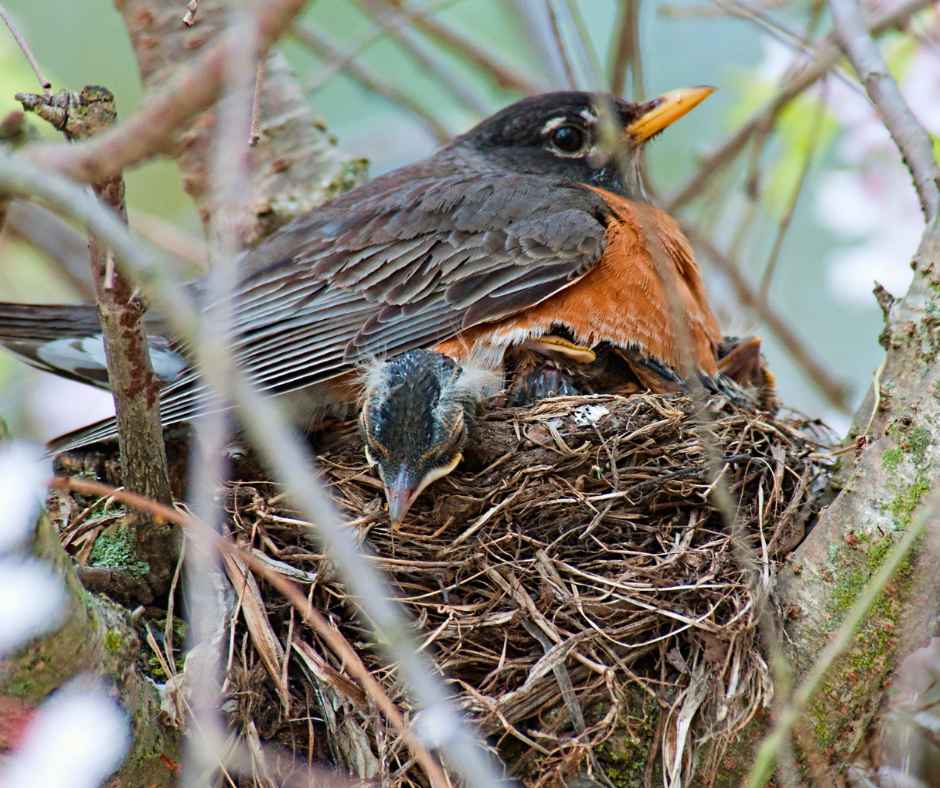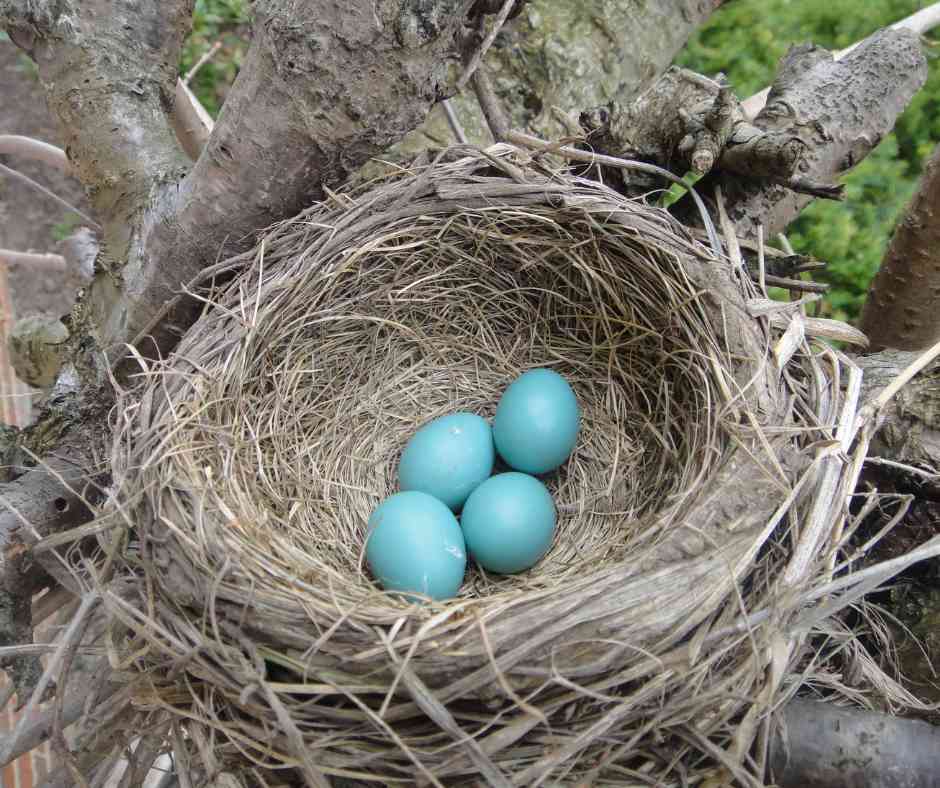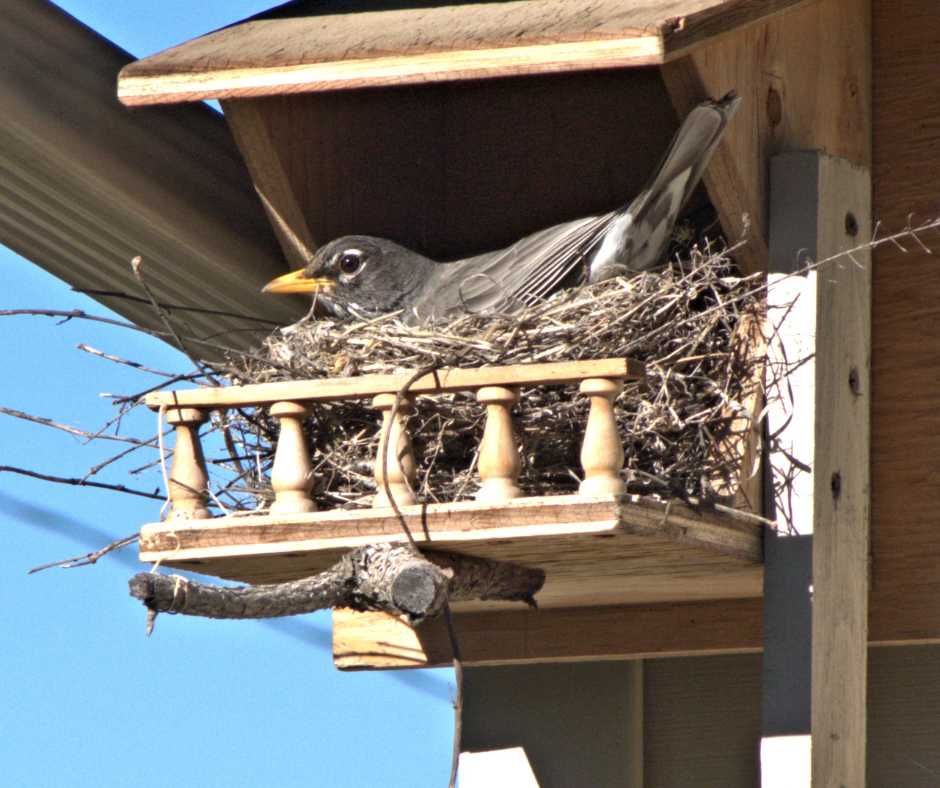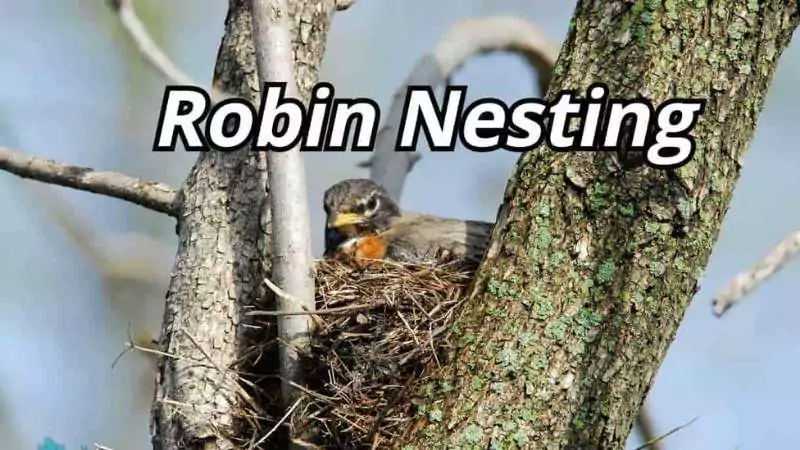Let’s take a closer look at American Robins and their amazing life right in our yards. Did you know what we do daily could make things challenging for these friendly birds? It makes us wonder how can we live together in a way that keeps their nesting ways safe and celebrated?
In this blog, we dive into the world of American Robin nesting. We’ll uncover where and how these challenging birds make their nests, from starting to build them to laying eggs and how they look after their little ones. We’ll see how Robins deal with changes we make to their homes and the problems they face. We’ll share how we can help them keep doing well.
Join us as we explore the life of these fascinating birds and learn how to make our spaces better for them. Whether you love birds or want to know more about nature, this guide will help you do good things for American Robins.
| Aspect | Details |
| Nesting Patterns and Locations | Robins choose safe locations like tree branches, bushes, or ledges. Nesting starts in early spring (April-July), with nests made of grass, twigs, and mud. |
| The Nesting Process: Construction to Egg Laying | Female Robins build nests using natural materials, laying 3-5 eggs per clutch in the early morning, one at a time. They can raise 2-3 broods per season, with eggs being about the size of a cherry and sky-blue in color. |
| Incubation and Brooding | Incubation lasts 12-14 days, with the female Robin warming the eggs almost constantly, supported by the male bringing food. |
| Growth and Fledging of Chicks | Eggs hatch in about 14 days, with chicks staying in the nest for around 13 days before fledging. Both parents feed the chicks, emphasizing teamwork in their care. |
| Protection and Adaptability | Robins protect their nests with alarm calls and may attack if needed. They rarely reuse nests, preferring to build new ones to avoid predators. Eggs are not moved once laid. |
| Nesting in Human-Modified Landscapes | Robins adapt to nesting in backyards and may use open platforms or structures resembling their natural nesting preferences instead of traditional enclosed nest boxes. |
| Challenges and Coexistence | Human activities can threaten Robins, leading them to abandon nests. Incubating Robin eggs requires specific conditions hard to replicate without expert knowledge, highlighting the importance of contacting wildlife rehabilitators for assistance. |
Nesting Patterns and Locations
Where do Robins nest?
Robins are not too fussy about their postal codes; they prioritize safety over the scenic view. You might spot their nests in the crook of a tree branch, hidden within a bush, or even on a quiet ledge near your home. These locations offer protection from predators and the elements, making them ideal for raising a brood. (You can read this for more in details)
When do Robins build nests?
As winter’s chill fades and spring’s warmth sets in, Robins get down to business. It typically happens around early spring. It’s a time of renewal and rebirth, not just for the flowers and trees but for the Robins, too, as they prepare to welcome new life.
When do Robins nest?
The nesting season for Robins stretches from April to July. During this time, they are swamped, building nests and raising their young. It’s a full-time job that might even see them raising several broods, one after the other, in a single season.
Read more: When Do Blue Tits Nest
What does a Robin’s nest look like?
A Robin’s nest is a work of art and engineering. It starts with a foundation of grass and twigs, chosen for their strength and flexibility. The Robins weave these materials together into a cup shape. Then comes the mud, applied carefully to bind everything together and give the nest its characteristic sturdiness. The finishing touch is a soft lining of finer grasses, making it the perfect cradle for Robin eggs.

Understanding these aspects of Robin life gives us a glimpse into the fascinating world of these familiar yet extraordinary birds. Their nesting habits reflect their adaptability and resilience, ensuring their survival and the continuation of their species.
The Nesting Process: Construction to Egg Laying
Have you ever watched a Robin during spring? It’s like seeing a busy contractor at work, but all the building materials come straight from nature.
How do Robins build nests?
Female Robins are the architects and builders of their nests. They start by collecting twigs, grass, and bits of mud, flying back and forth until they’ve gathered enough materials. Using their bodies, they shape these materials into a cozy cup. It’s like making a bowl out of papier-mâché, only with mud and plants instead of paper and glue!
How many eggs do Robins lay?
Once the nest is ready, the eggs are ready to hatch. A Robin mom usually lays three to five eggs, each gently laid in the nest and ready to start its journey.
When do Robins lay eggs?
These eggs don’t all come at once. Robins lay them one at a time, usually in the early morning. This way, each egg gets its share of care and warmth from the start.
How often do Robins lay eggs?
Robins are dedicated parents. They can repeat this process several times a season, raising two to three broods. It’s a busy life, but it’s all in a day’s work for Robin.
Size of Robin eggs
Robin eggs are small but mighty, about the size of a cherry. They’re known for their beautiful, sky-blue color – a sign of spring and new beginnings.

In this whole nesting dance, from construction to egg laying, Robins show us the beauty and complexity of nature. Each step is a testament to their hard work and dedication to the next generation.
Incubation and Brooding
After the hustle and bustle of nest-building and the careful laying of each egg, the Robin family moves into a quieter, but no less crucial, phase of their springtime saga: incubation and brooding.
Incubation of Robin Eggs
For about two weeks, the female Robin becomes a dedicated mom-to-be, warming her eggs to the right temperature. It’s a full-time job, with shifts lasting almost 24/7! She only steps away for quick breaks to stretch her wings or grab a snack. Imagine sitting still for that long – talk about patience!
How Long Do Robins Sit on Eggs?
These momma birds are glued to their nest during this time. They’re on egg duty day and night, only leaving for a few minutes to ensure they stay fed and healthy. Their warmth and care turn those eggs from Robin-blue to baby-bird-fluffy.
Do Male Robins Sit on Eggs?
While the moms are all in on incubation, what about the dads? Male Robins don’t sit on the eggs. Instead, they’re on guard and grocery duty, bringing food back to the nest for their mate and watching for any trouble. It’s teamwork at its finest.
Gestation Period of a Robin Egg
It takes 12 to 14 days after each egg is laid until little beaks crack through the shells. This gestation period is delicate, with the future of the nest hanging in the balance, nurtured by the steady warmth of the mother.
This period of incubation and brooding is a quiet prelude to the flurry of activity that will follow. It’s a testament to the dedication of Robin’s parents and a marvel of nature, where each moment is a step towards the next generation of these beloved backyard birds.

Growth and Fledging of Chicks
After the quiet anticipation of incubation, the Robin’s nest bursts into life. It’s a pivotal moment in the life cycle of these familiar backyard birds.
When do Robin eggs hatch?
The eggs show signs of life around two weeks after they’re lovingly laid. One by one, tiny chicks peck out, emerging into a world they’re eager to explore. It’s a big day in the nest, marking the start of a new chapter for the Robin family.
How long do baby Robins stay in the nest?
These baby Robins don’t stay tiny for long. They’re fast learners and fast growers. In about 13 days, these fluffy balls of feathers grow big enough and strong enough to think about leaving the nest. But until they’re ready to spread their wings, the nest is busy, full of gaping mouths and demanding chirps for food.
Do male Robins feed their young?
Absolutely! Robin’s parenting is a team effort. While momma Robin might have done the hard work of laying the eggs and keeping them warm, once those eggs hatch, dad Robin steps up to the plate. Both parents dart back and forth, fetching juicy worms and bugs for their ravenous brood. It’s a non-stop diner, with the chicks’ appetites seeming bottomless!

This bustling stage of growth and fledging is a whirlwind of activity. Once a quiet cradle of eggs, the nest is now a nursery full of life, with both parents fully engaged in caring for their young. It’s a testament to these feathered parents’ dedication and hard work, ensuring their chicks are ready to take on the world.
Protection and Adaptability
In the world of Robins, the nest is not just a home; it’s a fortress, a nursery, and a command center all rolled into one. Let’s explore how these feathery parents keep their babies safe and adapt to their ever-changing environment.
How do Robins protect their nest?
Robins keep their nests safe by making loud warning sounds to scare away animals that might harm them or their eggs. If a predator comes too close, robins aren’t afraid to dive-bomb at them to chase them away. They’re smart about where they build their nests too, picking spots that are hidden or way up high where it’s harder for predators to find them.
Do Robins reuse their nests?
Robins usually make a fresh nest for every batch of eggs they lay. They prefer to start from scratch to keep things clean and safe from germs and predators. Sometimes, they might build their new nest on top of an old one, but they don’t reuse the same nest as it was. This way, each new family gets a clean, safe start.
Do Robins use the same nest?
Sticking to one nest would be like eating at the same restaurant every day – boring and predictable! Robins like to mix things up, choosing new locations for each brood. It’s their way of keeping life exciting and safe.
Do Robins move their eggs?
Once those eggs are cozy in the nest, they stay put. Moving eggs could damage them, so Robins pick a safe spot from the start.
How do you take care of Robin eggs?
Found a Robin’s egg on the ground? It’s best to leave it where it is. Mother Nature knows best; sometimes, eggs end up outside the nest for a reason. Plus, moving it accidentally does more harm than good.
Robins are like superhero parents of the bird world in the grand scheme of things. They’re always on guard, ready to build a new home or fend off danger, all to ensure the next generation thrives in the great outdoors.
Nesting in Human-Modified Landscapes
Have you ever wondered if your backyard might be more than just a place for barbecues and summer fun? Well, for American Robins, it could be the perfect nesting spot. These adaptable birds are at home in various settings, including the cozy corners of human habitation.
Whether it’s a tree, a shrub, or even a ledge under your roof, Robins can transform it into a haven for their young. Their nests, made from twigs, grass, and mud, are often tucked away in these familiar yet unexpected places, blending seamlessly into our daily lives.
But what about those cute little birdhouses we put up hoping to attract feathered friends?
Robins are a bit picky here. They typically pass on traditional enclosed nest boxes. However, they’re not opposed to using open platforms or structures that offer more freedom and space, much like the ledges and branches they choose in nature.
This preference showcases the Robin’s love for openness, ensuring their nest is accessible yet secure from the elements and predators. So, consider setting up a nesting platform if you want to host a Robin family. It is the inviting space they want to raise their next brood right in your backyard.

Challenges and Coexistence
Living alongside American Robins means embracing boys and the challenges of being their neighbors with our best intentions; our actions can cause these birds to feel unsafe.
Do American Robins abandon their nests?
It’s true Robins may leave their nests if they sense too much noise, movement, or other disturbances. It’s their instinct to flee from potential danger to ensure their survival and that of their future offspring. This behavior underscores the importance of maintaining a respectful distance from nests and minimizing disturbances during the critical nesting period.
How do you incubate Robin eggs?
Finding a Robin’s egg without its mother in sight presents a tricky situation. While the instinct might be to help, it’s essential to know that incubating Robin eggs outside their natural environment requires specific conditions — temperature, humidity, and turning — that are hard to replicate.
The best course of action is to contact a licensed wildlife rehabilitator. These experts have the knowledge and resources to provide the eggs with the care they need, offering the best chance for the chicks to thrive. This approach supports Robin populations and respects the delicate balance of our shared ecosystems.
People Also Asked
How can I tell if a Robin has nested in my yard?
Look for nests in trees or shrubs and listen to the cheerful songs of the Robins. They’re pretty vocal, especially when they’ve got a nest nearby.
What should I do if I find a Robin’s egg on the ground?
It’s best to leave it be, as moving it might do more harm than good. If you’re concerned, contact a local wildlife rescue for advice.
Can I put out food for nesting Robins?
Absolutely! Robins love fruits and worms. Just make sure to place the food in a spot where it’s safe for the Robins to eat away from pets and predators.
Why do Robins sometimes abandon their nests?
If they feel threatened or the nest is disturbed too much, Robins might decide it’s safer to start over somewhere else.
How can I make my yard more Robin-friendly?
Plant native trees and shrubs, keep your cat indoors, and provide a water source. Creating a natural habitat is the key to having Robins (and other wildlife) feel at home in your yard.
Wrap Up
Diving into the world of American Robins, we learn more than just facts about birds; we uncover the art of living harmoniously with nature. By understanding how Robins build their nests, care for their eggs, and raise their young, we know how our actions affect them.
This knowledge empowers us to make our yards safe havens for these birds, ensuring they have the space to thrive. It’s all about mutual respect and support, creating an environment where humans and Robins coexist peacefully, enriching each other’s lives.

